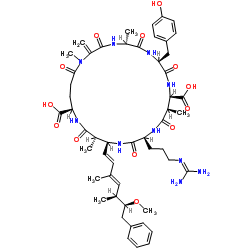microcystin yr

microcystin yr structure
|
Common Name | microcystin yr | ||
|---|---|---|---|---|
| CAS Number | 101064-48-6 | Molecular Weight | 1045.187 | |
| Density | 1.3±0.1 g/cm3 | Boiling Point | N/A | |
| Molecular Formula | C52H72N10O13 | Melting Point | N/A | |
| MSDS | Chinese USA | Flash Point | 11 °C | |
| Symbol |

GHS06 |
Signal Word | Danger | |
|
Inhibition of gap-junctional intercellular communication and activation of mitogen-activated protein kinases by cyanobacterial extracts--indications of novel tumor-promoting cyanotoxins?
Toxicon 55(1) , 126-34, (2010) Toxicity and liver tumor promotion of cyanotoxins microcystins have been extensively studied. However, recent studies document that other metabolites present in the complex cyanobacterial water blooms may also have adverse health effects. In this study we use... |
|
|
Highly sensitive detection and discrimination of LR and YR microcystins based on protein phosphatases and an artificial neural network.
Anal. Bioanal. Chem 404(3) , 711-20, (2012) The inhibition characteristics of three different protein phosphatases by three microcystin (MC) variants--LR, YR, and RR--were studied. The corresponding K (I) for each enzyme-MC couple was calculated. The toxicity of MC varies in the following order: MC-LR ... |
|
|
Comparison of the toxicity induced by microcystin-RR and microcystin-YR in differentiated and undifferentiated Caco-2 cells.
Toxicon 24 , 161-169, (2009) Cyanobacterial toxins, especially microcystins (MCs), are found in eutrophized waters throughout the world. Acute poisonings on animals and humans have been reported following MC exposure. Around 80 MCs variants have been isolated in surface waters worldwide ... |
|
|
Method for detecting classes of microcystins by combination of protein phosphatase inhibition assay and ELISA: comparison with LC-MS.
Toxicon 45(2) , 199-206, (2005) Depending on the class of microcystin the protein phosphatase inhibition assay shows different sensitivities to different classes of toxin. We have determined that the IC50 values obtained from dose-response curves for the inhibition of the enzyme by micro-cy... |
|
|
Characteristics of microcystin production in the cell cycle of Microcystis viridis.
Environ. Toxicol. 19(1) , 20-5, (2004) The correlation between the content of three microcystins (types LR, RR and YR) and the cell cycle of an axenic strain of Microcystis viridis, NIES-102, was investigated under conditions of high (16 mg L(-1)) and low (1.0 mg L(-1)) nitrate (NO(3)-N) concentra... |
|
|
Decomposition of microcystin-LR, microcystin-RR, and microcystin-YR in water samples submitted to in vitro dissolution tests.
J. Agric. Food Chem. 52(19) , 5933-8, (2004) The presence of cyanobacterial toxins (microcystins) in waters and food increases the risk of toxicity to animal and human health. These toxins can degrade in the human gastrointestinal tract before they are absorbed. To evaluate this possible degradation, wa... |
|
|
Occurrence of toxic blue-green algae in the Kucukcekmece lagoon (Istanbul, Turkey).
Environ. Toxicol. 20(3) , 277-84, (2005) The concentration of microcystin (MC) in the Kucukcekmece Lagoon, Istanbul, Turkey, and the physicochemical and biological parameters of water quality were investigated from October 2000 to June 2003. Water samples were collected from surface waters at three ... |
|
|
Microcystins -LA, -YR, and -LR action on neutrophil migration.
Biochem. Biophys. Res. Commun. 382(1) , 9-14, (2009) Microcystins (MCs) produced by some freshwater cyanobacterial species possess potent liver toxicity as evidenced by acute neutrophil infiltration. Here, we investigate the ability of three structurally distinct toxins (MC-LA, MC-LR, and MC-YR) to evoke neutro... |
|
|
ELISA and LC-MS/MS methods for determining cyanobacterial toxins in blue-green algae food supplements.
Nat. Prod. Res. 20(9) , 827-34, (2006) The use of natural products as a diet supplement is increasing worldwide but sometimes is not followed by adequate sanitary controls and analyses. Twenty samples of pills and capsules of lyophilised cyanobacteria (blue-green algae), commercialised in Italy as... |
|
|
Cardiotoxic injury caused by chronic administration of microcystin-YR.
Folia Biol. (Praha.) 56(1) , 14-8, (2010) Microcystins are cyclic peptide toxins. Chronic intoxication with well-known members of the microcystin family--microcystins-LR--induces liver tumour formation, injury of kidney and heart. Despite worldwide distribution in the environment, the effects of micr... |